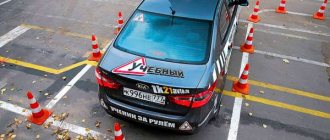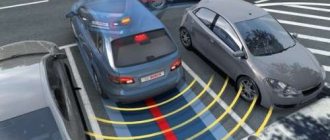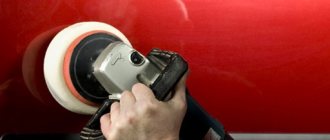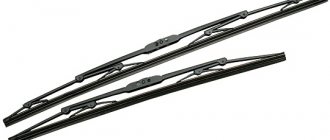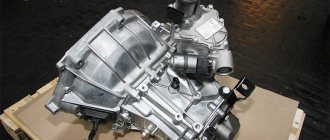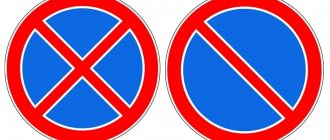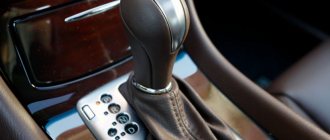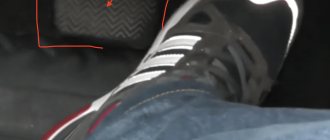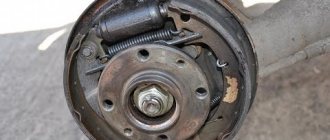Any driver, even one who doesn’t want to, will have to master parking skills. This dictates that we have a crazy number of cars, especially in large populated areas, where parking spaces are worth their weight in gold, and their size requires jewelry work behind the wheel.
Dear readers! The article talks about typical ways to resolve legal issues, but each case is individual. If you want to find out how to solve your particular problem , contact a consultant:
+7 (499) 938-81-90 (Moscow)
+7 (812) 467-32-77 (Saint Petersburg)
8 (800) 301-79-36 (Regions)
APPLICATIONS AND CALLS ARE ACCEPTED 24/7 and 7 days a week.
It's fast and FREE !
Designating sign
A parking sign in this way is represented by a combination of a “Parking” road sign and a plate that clearly demonstrates the method of parking at right angles to the roadway, with the bumper to the curb.
In some cases, depending on the image on the sign, parking on the curb is allowed (this will be reflected on the sign).
The plate itself covers certain categories of transport:
- Cars;
- motorcycles;
- mopeds;
- bicycles.
Other vehicles are prohibited from parking in parking spaces, as is parking on one of the specified types of transport, but in a manner other than that prescribed by the signs.
Workout
How to park backwards between cars in the city? To do this you need to have enough experience. It is better to start training in a free space, where there will be enough room for maneuver, and there will be no risk of hitting other people's cars. Where is the best place to start doing exercises? Any vacant lot or free parking lot will do. If you don’t have such places at your disposal, you can go to a garage or an open-air supermarket parking lot. Then you should mark out the parking space, using cones to imitate standing cars. From there, it’s all up to you: but the more practice you have, the more confident you will feel during “real” parallel parking.
Size
“Methodological recommendations for the design of parking areas for cars and buses” contain comprehensive uniform standards for the size of a parking space intended for parking any vehicle.
Any parking lot is designed and marked taking into account the requirements of the methodological recommendations.
Comparative table of parking space sizes for different parking methods and different types of transport in meters:
| Transport | Perpendicular parking | Parallel parking |
| Passenger car | 7,0*2,5 | 4,5*2,5 |
| Cargo | 11,0*3,5 | 8,0*3,5 |
| Truck with semi-trailer | 17,5*3,5 | 12,5*3,5 |
| Bus | 14,0*3,5 | 12,5*3,5 |
The parameters for driving between rows of parking spaces are taken from the Methodological Recommendations for the Design and Equipment of Roads to Ensure the Safety of Vehicle Movement .
These recommendations indicate that a U-turn for passenger vehicles requires 8 m , and for freight vehicles 9-12 m .
The passage between the rows of parking spaces is 6 meters , and in addition to this value is added the size of a free parking space, which is sufficient for maneuvering vehicles of any category.
Rear parallel parking test
As you know, parallel parking is part of the traffic police practical exam. How to park backwards during this exercise? The dimensions of the parking space during the exam are clearly regulated. To successfully complete the task, you need to place the car strictly outside the designated boundaries, without knocking over a single cone. First you need to drive up to the starting line. After the rear wheels cross it, you need to stop. Experienced drivers can start driving and turn the steering wheel at the same time - this will significantly reduce the load on the steering. But if you are just starting training, it is better to turn the steering wheel while standing still. Next, you should start moving backwards again, but with the steering wheel turned out.
When the corner cone is level with the driver's seat, you need to put the steering wheel straight and drive a little back. When the corner cone behind you is visible in the rear side mirror, you need to turn the steering wheel to the left and continue driving. The parking space is usually quite long, so it will not be difficult to park a car of any size there. After a certain amount of training that you do on the court, you will be able to quickly and accurately perform this exercise.
Methods
Mastering the rules of perpendicular parking at the proper level depends on:
- sensations of vehicle dimensions;
- developed practical skills in driving vehicles when reversing in a confined space;
- control and evaluation of mirror reflections;
- Understanding landmarks based on headlights.
Perpendicular parking requires skills that develop with experience. In order to practice and acquire them as quickly as possible, you can conduct periodic training sessions on the site where you need to make markings or simulating symbols, or markings, or parked cars in the neighborhood. At the same time, imitating objects should cause the minimum possible damage in the event of a practitioner’s vehicle hitting them.
Don’t know the difference between parking on paired and unpaired days? See the article about this: parking on even and odd days. The rules for parking in the local area of an apartment building are written here.
Key steps to remember
Special emphasis needs to be placed on some stages of parking:
- The space where the machine will be placed must correspond to its dimensions. At the same time, you need to realistically evaluate your parking skills.
- The positioning of the vehicle must comply with traffic regulations and signs.
- Before performing the maneuver, you need to make sure that there are no prohibiting signs or obstacles.
- Once the maneuver is completed, you need to make sure that no obstacles are created for other cars in the parking lot.
- When reversing, it is better to use the emergency lights. This way other drivers will be additionally warned about the maneuver.
Every driver should focus on 5 factors:
- Auto control.
- Traffic safety.
- Situations around the car.
- Compliance with the Rules.
- Behavior of other traffic participants.
Step-by-step instruction
Beginners prefer to park perpendicularly, entering a parking space in front, believing that it is easier this way.
In fact, the car has greater maneuverability when entering a parking space backwards and less free space is required for this.
But due to lack of experience, attentiveness, etc. For some, such a task remains mission impossible.
Reversing
Algorithm for parking backwards perpendicular to the curb through a left turn of the steering wheel:
- decide on a parking space (find a free one, so that after parking the distance from the neighboring left and right cars is at least 40 cm );
- drive forward along the driveway between the conventional parking rows until the rear lights are level with the edge of the free parking space;
- turn the steering wheel all the way to the left and make sure that there are no people or other vehicles behind to avoid an accident;
- engage reverse gear and slowly start moving while simultaneously monitoring the situation for the appearance of interference through the rear view mirror, as well as the side mirrors;
- when the car is positioned parallel to adjacent ones or placed perpendicular to the driveway, you need to start turning the steering wheel to the right until the wheels are in a position to move straight;
- In case of minor deviations in the position of the machine, moving forward and backward should correct the situation.
Parking backwards into a garage perfectly imitates perpendicular parking.
In front
Algorithm of actions for perpendicular parking in front:
- analyze the surrounding environment with an emphasis on the selected parking location;
- turn the steering wheel all the way so that the wheels are in the extreme right or left position, depending on the side of the parking space;
- engage first gear and slowly start moving;
- observe what is happening, stop the vehicle when approaching the car on the sides closer than 50 cm ;
- control the distance to left-handed and right-handed vehicles to avoid contact;
- If there are deviations from a right angle upon arrival, you should straighten the car by moving forward and backward.
For beginners, it is better to park and exit during daylight hours, when there is a better view of what is happening around.
By mirrors
When parking using mirrors, it is worth considering that:
- Some mirrors distort the image (they move away or, on the contrary, bring closer). Drivers who have experience driving a specific car and know the specifics of mirrors should rely on mirrors;
- if there is a towbar, do not forget about its length, which is located outside the bumper. The main problem is that it is not visible in the mirror, so you need to take another element as a reference and mentally take into account the margin.
Dynamic dimensions of the car
The car turns relative to a point lying on the extension of the rear axle. The vehicle's turning radius is adjusted by turning the front wheels. Accordingly, the more the wheels are turned, the smaller the turning radius. But do not forget about the protruding parts of the car - these are the front and rear fenders.
Therefore, when the car turns, it seems to become wider. This phenomenon is usually called a change in overall width, and the change in size itself is called the dynamic dimensions of the car. When turning and, especially when parking, you must take this feature into account. In general, this feature can be attributed to the physics of car movement, but the main thing here is to understand how the car turns.
There is an unwritten rule that people always forget or ignore. It goes like this: You should try to treat other road users with respect. In relation to car parking, this rule looks something like this:
- Follow the requirements of road signs;
- Park your car as quickly as possible to make way for other cars to pass;
- Take up as little space as possible in the parking lot to leave free space for parking other cars;
- Ensure free exit from the parking lot, as well as free passage for pedestrians;
- If possible, park in reverse so you can leave the parking space in forward;
- Avoid parking on slopes and slopes, as well as on narrow streets;
- In the parking lot, open the doors carefully so as not to damage the doors themselves and the bodies of nearby cars.
Below are several ways to park a car. How parking differs from parking is in the article Terms “Stop” and “Parking” in traffic regulations.
Subtleties and mistakes
When parking, many people underestimate the situation, believing that this maneuver does not pose a danger since other cars are stationary, and all actions are performed at low speeds.
But from a collision with another car, hitting a curb, etc. no one is immune.
Conditions for correct and safe parking:
- concentration and extreme attentiveness;
- analysis of information from mirrors, both side and rear view;
- taking into account the capabilities of the car: front-wheel drive vehicles have a larger turning radius than rear-wheel drive vehicles;
- take into account the parameters of the car and the selected parking place; after stopping the vehicle, there must be distances between neighboring cars at the parking place in order to freely get in and out of the car and not interfere with passengers and the driver of the neighboring car doing the same.
conclusions
Every driver should know how to properly park backwards between cars. This makes life much easier and helps you park your car in free space quickly and accurately. As with any activity, practice is required in this area. For experienced drivers, parallel and perpendicular parking does not cause any difficulties; they can easily get into even small spaces. But if you are driving recently, then you should be careful and attentive while driving, and also learn the theory and scheme of reverse parking in advance.
Comments for the site
Cackl e
Fine
Parking rules are regulated by law. The traffic rules define the range of places where parking is allowed and where it is prohibited. Ignoring the requirements is punishable administratively (Article 12.19 of the Code of Administrative Offenses of the Russian Federation).
But even though there is one article for illegal parking, the penalties differ for specific actions.
So, if you park at a railway crossing or in an unacceptable proximity to it, the penalty will be either 1000 rubles or deprivation of your license for 3 months . When parking on the sidewalk, pedestrian crossing, or in a public transport stop zone, the fine will be 1,000 rubles , but similar actions in Moscow and St. Petersburg will empty your wallet by 3,000 rubles (all because the parking problem is most acute in these megacities).
Want to know what the fine is for violating parking rules? Read about this in the article: illegal parking. Read about what flat parking is here.
For more information about what a parking assistance system is, see here.
What to do if you hit someone else's car?
Unfortunately, sometimes even experienced motorists have difficulty parking backwards. If you did not calculate the trajectory of movement and accidentally hit a stationary car, you are obliged to call the traffic police to the scene of the accident. It is strictly not recommended to leave the parking lot, as this may result in your driving license being deprived for up to 2 years. You can also negotiate with the owner of the car or fill out the Europrotocol without calling the traffic police. As a rule, traffic speeds in parking lots are low, and therefore little damage is caused to cars. So a fine of several thousand rubles for a scratch or broken headlight will clearly cost you less than deprivation of the right to drive a car.
